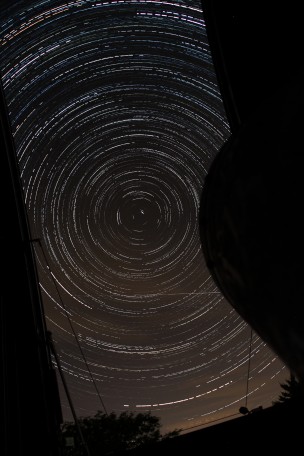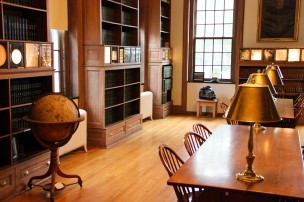
Jakob Schaeffer/Contributing Photographer
It’s been four weeks now, yet I keep coming back. Each time I try, my advances are denied. It seems as though the fates are conspiring to keep us apart. The stars are simply not aligning.
In reality, it’s the cloudy weather that has repeatedly thwarted my attempts to attend the weekly Wednesday public star-gazing hours at Van Vleck Observatory on Foss Hill.
For the year and a half that I’ve been on campus, I have meant to attend one of these viewings.
“We invite members of the Wesleyan and Middletown community to come view the skies through our telescopes,” reads the program listing in the Wesleyan Weekly Calender. “This event is free and open to everyone. Wednesday night observing will not happen during University holidays or during final exams. Clear skies are mandatory.”
That last sentence has been the only barrier between me and celestial beauty. This time, however, I did not let mere clouds keep me from visiting the observatory.
“Observing only happens when it is clear,” Research Assisant Professor of Astronomy Roy Kilgard, who runs the observatory. “So unfortunately it doesn’t happen nearly as frequently as we would like.”
This has been especially true these past couple of weeks, as very cloudy weather and freak snowstorms have kept the Observatory closed.
After trying for so long, however, I decided that nothing would keep me from the Observatory this week, and I asked to be given a tour anyway, hoping that simply seeing the telescopes would be enough to sustain me until a clear sky could show me the stars, planets, galaxies, and nebulae.
Jakob Schaeffer, a masters student in the Astronomy Department, let me into the building and showed me around. According to him, my timing was just off.
“We had a string of really nice weeks earlier this year,” Schaeffer said.
Unfortunately, weather waits for no one, so I could only look at, rather than through, the telescopes. Schaeffer explained that there are three main telescopes, but only two are open to the public.
“The 24-inch telescope, adjacent to the parking lot, is used exclusively for research and upper-level courses,” Associate Professor of Astronomy Edward Moran said.
Last year, Marshall Johnson ’11 used this telescope to discover an exoplanet and became the first undergraduate ever to do so.
“The 20-inch telescope (in the big dome) is now only used for some public events and general education courses,” Schaeffer said. “It gives exquisite images but is a bit cumbersome to use. The 16-inch telescope in the little dome is used for Wednesday public nights and gen-ed courses. It’s pretty good but is computer controlled and can be easily moved.”
To get to the 16-inch telescope (the size refers to the lens diameter), I had to walk up a rickety, winding staircase. As I climbed, my heart began to race; I expected to find something dark and mysterious, like what I imagine I would see in an old film noir.
Instead, I was slightly disappointed. The small, white iron dome was almost entirely filled with a surprisingly unimpressive telescope. As the rain was still pelting the dome, Schaeffer could not let me look through the lens, but I could look into it (the wrong way), which was kind of cool. A double-mirror reflection gazed back at me.
Schaeffer, however, prefers the 20-inch, and once I began walking around the telescope inside the dome, it was easy to see why.
“This one’s my favorite because it has a cool aura, and it’s an elevator,” Schaeffer said. “The dome is much bigger, too. It’s a 30-foot long tube, and you have to manhandle it. You feel like an old-timey astronomer. The other one, it’s kind of an off-the-shelf. You could buy it if you have a lot of dough.”
The older telescope, which is used only for public viewing, is far more impressive, even if the telescope is of a slightly lower quality (Schaeffer says the difference is negligible to the naked eye). Lined by brick, the huge circular room is covered by the white steel dome that is visible as you pass the observatory.
This iconic part of Wesleyan’s landscape is impressive on the inside as well. My feet echoed in the space, which made the room impressive, yet hospitable; I felt as though an eccentric stranger was welcoming me into his home.
The telescope looks like a refugee from an old naval ship; in actuality, it is just a huge, hollow tube with a lens on either end. What is deceptively simple allows the naked eye to see unimaginable distances and impressive celestial events.
Schaeffer climbed a large rickety ladder to twist some knobs and pull on a string—“manhandling,” as he called it—just to move the bulky instrument.
“The dome is just so much bigger,” he said. “You can see much more of the sky.”
This telescope, however, is usually used only for special occasions and is only in operation right now because the 16-inch is under maintenance.
“Whenever anything of visual interest happens (such as comets), we will schedule special observing sessions and announce them on our website, the Wes calendar, Twitter, etc,” Professor Kilgard said. “We also have public observing one Saturday evening per month in cooperation with a group of amateur astronomers in the area, The Astronomical Society of Greater Hartford. We also host private observing sessions for any interested groups, primarily scout groups and elementary/middle school students. But we have done observing sessions for program houses and other campus organizations as well.”
On an average day, about eight to 15 people show up, according to Schaeffer.
“Sometimes you get one or two,” Schaeffer said, “but other times you have people jammed right in the dome up there.”
Anyone can go to the observatory, and the rules are pretty relaxed—as evidenced by my visit during non-official hours. Even beyond looking through the telescope, there are many ways for non-astronomy students to get involved.
“First, they may volunteer to assist with public observing,” Professor Moran said. “Second, they can volunteer as science observers, taking images with our 24-inch telescope for research projects being conducted by the faculty. Third, interested students may contact me for more information.”
According to Schaeffer, anyone can volunteer to do research for the Astronomy Department and get to use the telescope once a week. Such research is even paid.

Jakob Schaeffer/Contributing Photographer
Our tour didn’t stop at the telescopes, however. I was also let into what may be the best kept secret at Wesleyan: the observatory library.
Light boxes with celestial photos of fires, moons, stars, and planets lined shelves filled with black- and green-bound books. Multiple globes and models of the solar system stretched across the room, and standing lamps on long wooden tables were positioned next to slightly uncomfortable wooden chairs. Plants, old mental drawers, rolling ladders, and a darkly painted portrait all gave the library the feel of Darwin’s era.
The space was peaceful. I could have studied or read in there for hours, feeling at home among the tools that people have used for generations to gaze at celestial bodies twinkling in the night sky.
I was sad to leave, but excited to return, if only to actually use the telescope, my original reason for journeying to the top of Foss on a cold and rainy November night.
“Come look through a telescope before you graduate!” Professor Kilgard said. “Especially if Saturn is up—it’ll take your breath away. Historically, a little more than a third of all Wesleyan students take an astronomy course before graduating. But I can’t count the times an alum, who has come to stargaze at homecoming or reunion weekend, has said to me, ‘This is my first time in this building.’”